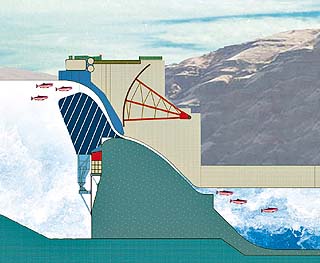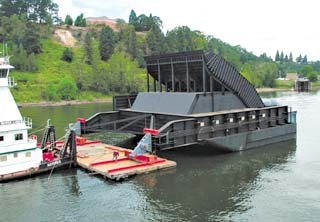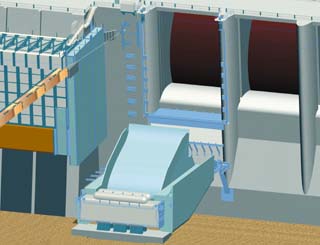
Surveys
DJC.COM
July 17, 2003
A salmon-friendly solution on the Snake
Jacobs Civil

Voskuilen
|
Often described as the Academy Awards of engineering, the ACEC competition is a showcase of the nation’s engineering accomplishments. A few of the previous winners include the I-205 Columbia River Bridge, the Vandenburg Space Shuttle Complex, the Fort McHenry Tunnel and the St. Louis Metrolink project.
The top project this year was not a mega sports complex nor a major bridge structure — it was a fish passage device at Lower Granite Lock and Dam in Eastern Washington designed by Jacobs Civil. It’s a project that few people will ever see.

Renderings courtesy of Jacobs Civil
A removable spillway weir, shown in the operating position, works like a large water slide, providing safer and more efficient passage for migrating salmon. It also saves water by allowing more fish to pass for each gallon of water spilled.
|
The challenges encountered for the Lower Granite Lock and Dam removable spillway weir (RSW) project were significant. We had operational constraints imposed by possible flood conditions. We had an unusual structural shape dictated by a combination of biology, hydraulics and structural limitations. We had a massive and unusually shaped structure to build and then transport hundreds of miles from its fabrication site to the project.
All of this had to be done on an aggressive schedule.
The massive RSW structure is constructed from nearly 2 million pounds of steel plate, cut and formed to create the desired geometry and to mesh smoothly with the existing dam structure. It is over 100 feet tall, 83 feet wide and nearly 60 feet from upstream to downstream.
The RSW was built in Vancouver at Thompson Metal Fabricators. Dix Corp. of Spokane was the general contractor.
Despite weighing more than two fully loaded 747-400’s, the structure was floated to the project site using two tugs. The journey was completed in about four days.
Because the new weir partially blocks the spillway and reduces the flood handling capacity of the dam, it was necessary to design a way for it to be removed.

Photo courtesy of Jacobs Civil
Tugs were used to move the weir from its fabrication plant in Vancouver to the dam.
|
The solution was a unique but simple method for removing the structure from the spillway ahead of flood flows. The massive structure attaches to the dam with large hinges connected to supports deep in the reservoir. Using a complex system of internal air ballasting in watertight internal compartments, the structure was designed to rotate back into the reservoir to a fully submerged position to restore the full spillway capacity.
In the lowered position, the RSW rests on a landing pad constructed and precisely placed in water over 100 feet deep.
Testing of the completed RSW during the 2002 spring migration documented the effectiveness of the structure’s unique design with better than expected fish passage results. Test data for 2003 has been collected and is currently being processed.
The success of the RSW at Lower Granite has led the Army Corps to consider other potential sites where RSWs might simultaneously improve fish passage and water usage.

The weir, shown in the stowed position, fits into one of eight spillways at Lower Granite Lock and Dam on the Snake River. |
The goal of restoring salmon populations in the Northwest, while balancing human needs has been, and continues to be, a difficult task. A unique and creative engineering community is required to be able to adapt designs to the biological requirements of fish. In the process, engineers have become an instrumental part of fish restoration efforts. This has resulted in enhancement of not only fish populations, but also the stature of the engineering profession as stewards of the environment.
The Lower Granite RSW has served as an example of the creative application of engineering to a unique project and gives us some optimism that the challenges that face us are not insurmountable.
M. Reece Voskuilen, PE, is a civil engineer with 24 years of experience and specialized expertise in the design of fish hatcheries, fish bypass systems and general site facilities. He was Jacobs’ project manager for the RSW.
Other Stories:
- Battle over keeping dams rages on
- Be prepared with a spill management plan
- What’s your vision for Seattle’s future?
- Hat Island gets a drink from the sea
- Foss Waterway cleanup kicks into high gear
- Reclaimed water — a ‘new’ water supply
- LOTT dives into reclaimed water
- Clean air: saving our competitive advantage
- Europe points the way to sustainability
- Old maps handy for site investigations
- Planning for an environmental emergency
- Engineered logjams: salvation for salmon
- Development can be beneficial to wetlands
- Check out properties with microbial surveys
- Sculpting a park out of a brownfield
- Charting a sustainable course for the Sound
- Water rights no longer a hidden asset
- The economics of sustainability
- Laying the path for responsible education
- Squeezing more out of renewable energy
- Controlling mosquitos and the environment
- Beavers back in force in the Seattle area
- Our future: no time or resources to waste
- Port Townsend dock promotes fish habitat
- Brownfields program is here to stay
- Master Builders teaches green homebuilding
- Pierce County maps where its rivers move
Copyright ©2009 Seattle Daily Journal and DJC.COM.
Comments? Questions? Contact us.